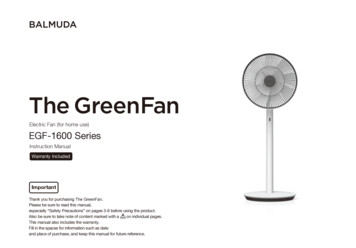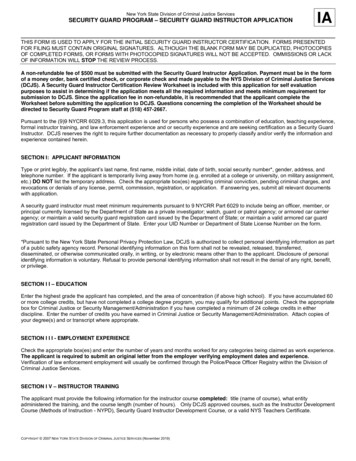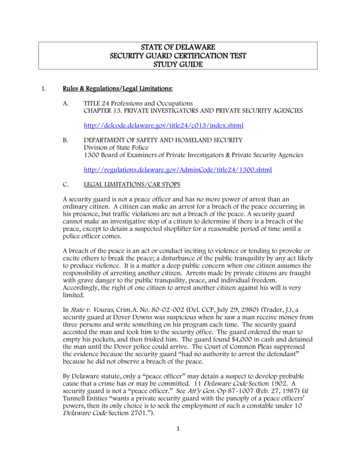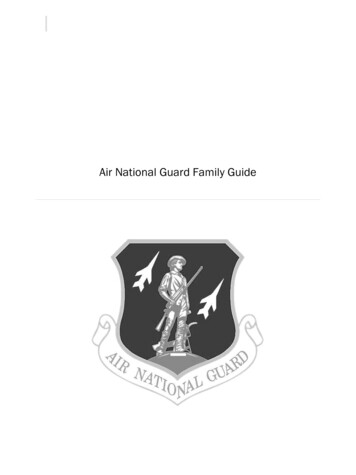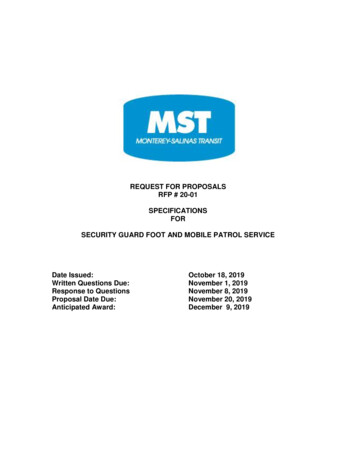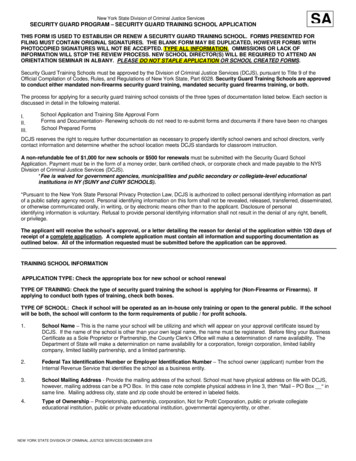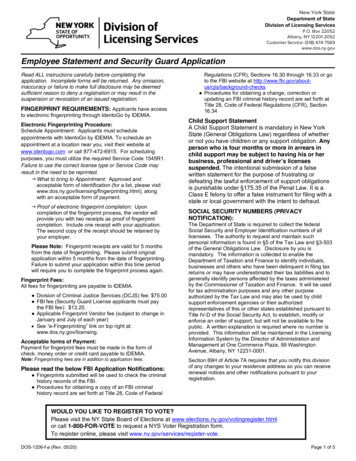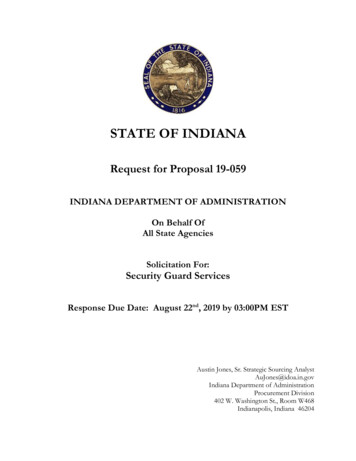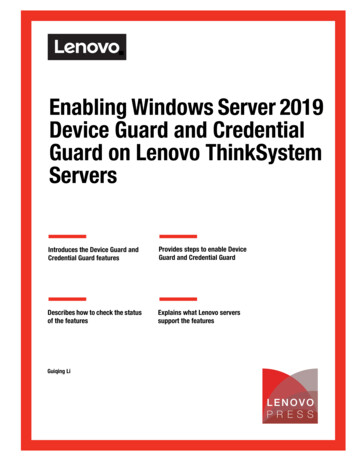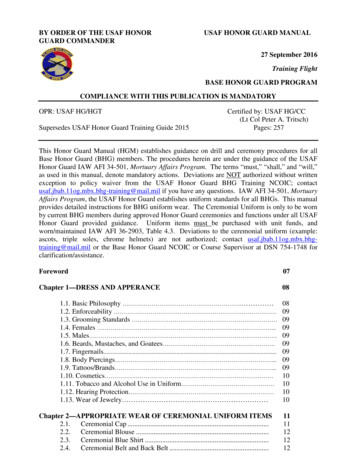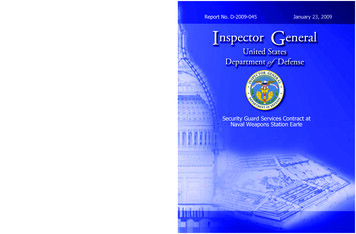
Transcription
Report No. D-2009-045January 23, 2009Security Guard Services Contract atNaval Weapons Station Earle
Additional Information and CopiesTo obtain additional copies of this report, visit the Web site of the Department of DefenseInspector General at http://www.dodig.mil/audit/reports or contact the Secondary ReportsDistribution Unit at (703) 604-8937 (DSN 664-8937) or fax (703) 604-8932.Suggestions for AuditsTo suggest ideas for or to request future audits, contact the Office of the Deputy InspectorGeneral for Auditing at (703) 604-9142 (DSN 664-9142) or fax (703) 604-8932. Ideasand requests can also be mailed to:ODIG-AUD (ATTN: Audit Suggestions)Department of Defense Inspector General400 Army Navy Drive (Room 801)Arlington, VA 22202-4704Acronyms and QAEQAPContract Discrepancy ReportFederal Acquisition RegulationFacilities Support Contract ManagerInspector GeneralMaintenance and Operation ManualNational Agency CheckNaval Facilities Engineering CommandNaval Weapons StationOffice of the Chief of Naval Operations InstructionQuality AssuranceQuality Assurance EvaluatorQuality Assurance Plan
iINSPECTOR GENERALDEPARTMENT OF DEFEN SE400 ARMY NAVY DR IVEAR LI NGTON, VIRGI NIA 22202-4704January 23, 2009MEMORANDUM FOR UNDER SECRETARY OF DEFENSE FOR ACQUISITION,TEC HNOLOGY, AND LOGISTICSNAVAL INSPECTOR GENERALSUBJECT: Security Guard Services Contract at Naval Weapons Station Earle(Report No. D-2009-045)We are providing this report for review and comment. We considered comments from theCommander, Navy Installations Command; Naval Facilities Engineering Command, Mid-Atlantic;and the Commander, Naval Weapons Station Earle when preparing the fin al report.DoD Directi ve 7650.3 requires that all recommendations be reso lved promptly. The conU11entsfrom the Commander, Navy Installations Command were responsive. However, the commentsfrom Naval Facilities Engineering Command, Mid-Atlantic were only partially responsive.Therefore, we request additional comments from Naval Facilities Engineering Conunand, MidAtlantic on Recommendati ons B.2.b. and B.2.c. by March 23, 2009.Please provide conunents that conform to the requirements of DoD Directive 7650.3 . If possible,send your comments in electronic fo rmat (Adobe Acrobat fil e only) to AU DACM@dodig. mil.Copies of your comments must have the actual signature of the authorizing offi cial fo r yourorgani Zation. We are unable to accept the I Signed I symbol in place of the actual signature. Ifyou arrange to send classified conU11ents electroni call y, yo u must send them over the SECRETInternet Protocol Router Network (SIPRNET).We appreciate the courtesies extended to the staff. Questions should be directed to me at (703)604-9201 (DSN 664-9201 ). & ,Richard B. Jo lliffeAssistant Inspector GeneralAcqui siti on and Co ntract Management
Report No. D-2009-045 (Project No. D2008-D000CG-0116.000)January 23, 2009Results in Brief: Security Guard ServicesContract at Naval Weapons Station Earle What We Did This report responds to CongressmanChristopher H. Smith’s request that the DoDInspector General review the security guardservices contract at Naval Weapons StationEarle, New Jersey, in light of the Navy’s plan toopen base housing to the public. Thecongressional request included allegations thatMyers Investigative and Security Service, Inc.,violated its contract with the Navy.What We Recommend We reviewed contract administration andcontractor performance for the security guardservices contract to determine whether the Navyproperly administered the contract and whetherthe contractor performed according to contractrequirements. We also addressed the followingspecific allegations contained in thecongressional request. The contractor did not conduct backgroundchecks on prospective contractor employees. The contractor did not properly staff securityshifts. The contractor did not properly trainsecurity guards and falsified trainingdocumentation. A security exercise identified security flaws. The Navy should maintain a record of whencontractor employees complete criminalbackground checks and National AgencyChecks.The Navy should implement procedures todocument that contractor security guardshave completed Navy required training.The Navy should revise the qualityassurance plan to comply with Navyrequirements, and implement an appropriatesurveillance plan.The Navy should provide the requiredtraining to quality assurance personnel.Corrective ActionsThe Navy provided draft comments inJanuary 2009 stating that they modified thecontract for processing National AgencyChecks. In addition, the Navy revised thequality assurance plan to include randomsampling.Navy Comments and OurResponseWhat We Found The Navy did not perform quality assuranceaccording to Navy guidance.The Navy did not adequately documentcontractor performance.The Navy was not able to provide documentation showing that all contractor securityguards had completed a background check.With few exceptions, the contractor wasproperly staffing security posts.The contractor did not document whethersecurity guards completed all trainingrequired by the contract.Navy security assessments did not identifyany significant security concerns about thecontractor security guards.The Commander, Navy Installations Command;Naval Facilities Engineering Command, MidAtlantic; and the Commander, Naval WeaponsStation Earle concurred with ourrecommendations. However, the NavalFacilities Engineering Command, Mid-Atlanticcomments on one recommendation were onlypartially responsive and on anotherrecommendation were nonresponsive. Pleasesee the recommendations table on the back ofthis page.i
Report No. D-2009-045 (Project No. D2008-D000CG-0116.000)January 23, 2009Recommendations TableNavyRecommendationsRequiring CommentNo Additional CommentsRequiredB.1.B.2.b., B.2.c.A.1.a., A.1.b., B.2.a.Commander, NavyInstallations CommandCommander, Naval FacilitiesEngineering Command, MidAtlanticCommander, Naval WeaponsStation EarleA.2., B.3.a., B.3.b.Please provide comments by March 23, 2009.ii
Table of ContentsResults in BriefiIntroduction1ObjectivesBackgroundReview of Internal ControlsFinding A. Security Concerns: Allegations and ResponsesNavy Planned Corrective ActionsRecommendations, Navy Comments, and Our ResponseFinding B. Improved Quality Assurance Needed for SecurityGuard Services ContractNavy Corrective ActionsRecommendations, Navy Comments, and Our Response11251414172727AppendixScope and MethodologyPrior CoverageDepartment of the Navy Comments313233
IntroductionObjectivesThe audit objective was to determine whether the Navy properly administered thecontract and whether the contractor performed according to contract requirements. Inaddition, the audit addressed specific allegations raised in the congressional request.Please see the appendix for scope and methodology and prior audit coverage.BackgroundCongressman Christopher H. Smith, who represents New Jersey’s fourth district,requested that the DoD Office of Inspector General (IG) review the security guardservices contract at Naval Weapons Station (NWS) Earle, New Jersey, followingcomplaints from a former contractor employee about security procedures.A former employee for Myers Security and Investigative Services, Inc. (Myers) contactedCongressman Smith about alleged lapses in the security procedures at NWS Earle. Theallegations were as follows. Myers was not conducting background checks on prospective contractoremployees. Myers was not properly staffing the security posts at NWS Earle. Myers did not properly train security guards and falsified training records. A security exercise identified security flaws at NWS Earle.See finding A for a discussion of the allegations and DoD IG responses.The DoD Office of Inspector General issued DoD IG Report No. D-2008-116, “DoDSection 801 On-Base Housing,” on August 12, 2008, concerning the proposed leasing of300 section 801 housing units located on base at NWS Earle by Laurelwood, Inc. Theaudit determined that NWS Earle officials were acting within the terms and conditions ofthe 1988 Section 801 housing agreement with Laurelwood, Inc., and the Navy willreview security considerations for inclusion in the Environmental Impact Statement.NWS EarleNWS Earle is located in Colts Neck, New Jersey, and is one of three naval weaponsstations on the East Coast. The station occupies 11,851 acres and comprises two separateland-holdings connected by a 14-mile highway and rail line. NWS Earle’s missionincludes: receiving, renovating, maintaining, storing, and issuing ammunition, explosives,expendable ordnance items, and weapons and technical ordnance materiel; providing logistics and administrative support to home-ported ships; and1
performing additional tasks as directed by the Commander, U.S. Fleet ForcesCommand or similar authority.NWS Earle has its own police force, which is responsible for law enforcement and visitorcontrol, and also oversees a contracted guard force that provides gate guards and rovingpatrols.Security Guard Services ContractThe Naval Facilities Engineering Command (NAVFAC) awarded a firm-fixed-price,indefinite-quantity contract for security guard services at NWS Earle to Myers onJanuary 29, 2004. NAVFAC awarded the contract for an initial 7-month period (March 1through September 30, 2004) at a cost of 1.9 million with 4 option years. As ofSeptember 2008, the contract at NWS Earle was in its fourth option year, with the totalcost of the contract and the exercised options estimated at 20.7 million. The fixed-pricecontract required that the contractor furnish all labor, supervision, materials, equipment,transportation, and management necessary to provide armed guards, patrols, and relatedservices to protect personnel, property, facilities, and land. The contractor does notperform law enforcement at NWS Earle, but is mainly responsible for the prevention ofunauthorized access to the base through the use of entry controls, exit controls, androving patrols. NAVFAC Mid-Atlantic Public Works Department, NWS Earle, providescontract administrative services and quality assurance (QA) for the security guardservices contract.Quality Assurance RequirementsThe Federal Acquisition Regulation (FAR) and the NAVFAC “Facility Support ContractQuality Management Manual (MO-327),” July 1, 1994, provide requirements for QA.FAR Subpart 46.4, “Government Contract Quality Assurance,” requires the creation of aquality assurance plan (QAP) that specifies all contract work requiring surveillance andthe surveillance method. Maintenance and Operation Manual (MO)-327 providesguidance for creating and administering the plan. MO-327 states that QAPs:(a) Provide quality assurance evaluators (QAEs) with a systematic planfor the surveillance of the contractor’s work,(b) Provide the methods for collecting information necessary toevaluate the contractor’s performance,(c) Provide a basis for documenting the official contract file on matterspertaining to performance and quality,(d) Provide the methods for collecting data to justify deductions to thecontract price in the event of unsatisfactory performance by thecontractor, and(e) Provide shore establishment with a basis for providing QAresources at an adequate level.Review of Internal ControlsWe identified no material internal control weaknesses for the security guard contract atNWS Earle. However, the Navy’s internal controls over contract administration wereinadequate as they applied to the audit objectives because Navy personnel were not2
adequately performing and documenting Government oversight. ImplementingRecommendations A.1., A.2., B.1., B.2., and B.3. will correct the internal controlweaknesses.3
4
Finding A. Security Concerns: Allegationsand ResponsesDoD IG received a request from Congressman Christopher H. Smith to reviewcompelling security concerns at NWS Earle in light of the Navy’s plan to open basehousing to the public. The congressional request included allegations by a formercontractor employee of violations of the contract between the Navy and Myers. Theallegations included the following. Myers did not conduct background checks on prospective contractor employees. Myers did not properly staff security shifts. Myers did not properly train security guards and falsified training documentation. A security exercise identified security flaws.The allegations included in the congressional request from Congressman Smith arediscussed below.Allegation 1. Background ChecksMyers did not conduct background checks on prospective contractor employees.1DoD IG ResponseNavy security personnel were not able to provide documentation that all contractorsecurity guards had completed required security checks because the Navy did not alwayskeep the results of criminal background checks or National Agency Checks (NACs).Therefore, we were unable to determine whether the required security checks werecompleted for all contractor security guards.Criminal Background ChecksNWS Earle security personnel provided documentation showing that the Navy completeda criminal background check for 43 contractor security personnel in our 45-personjudgmental sample. The appendix provides additional detail on the sample. Contractorsecurity personnel are required to undergo a criminal background check to work assecurity officers at NWS Earle. NWS Earle security personnel provided documentationshowing that 43 of a judgmental sample of 45 current and former contractor employeeshad completed a criminal background check. According to the NWS Earle securitydirector, NWS Earle security personnel conduct criminal background checks oncontractor personnel. The contractor submits an application that NWS Earle securitypersonnel use to complete the criminal background check through the Federal Bureau ofInvestigation Criminal Justice Information Services. The criminal background checkapplication includes a signature block for Navy personnel to sign on the completion ofthe criminal background check. Navy personnel signed 43 of the 45 applications for1The Navy, not the contractor, conducted background checks.5
personnel in our sample. NWS Earle security personnel provided the applications asproof that the checks were approved; however, we could not determine whether theNavy approved checks for 2 of the 45 contractor security guards in our sample becausethe applications were not signed. In addition, of the 43 signed applications, 22 were notcompleted before the individuals’ hire date. The Navy should implement procedures todocument the completion of criminal background checks. The figure shows thebreakdown of the signed application forms obtained for the judgmental sample of45 contractor employees.2 of 4522 of 4521 of 45No documentation of approved applicationApplication approved before hire dateApplication approved after hire dateNote: Figure represents a judgmental sample of 45 current and former employees. It does not represent allcontractor employees. Among all contractor employees, there may be individuals having no documentationof a criminal background check.Contractor Security Guards’ Applications for Criminal Background ChecksNational Agency CheckNavy personnel provided documentation showing that 16 of a judgmental sample of24 current and former contractor personnel had applied for a NAC. Navy personnel alsoprovided documentation that the Office of Personnel Management completed NACs for13 of the 24 contractor personnel. The NWS Earle installation security managerexplained that he did not know whether he was required to keep a copy of the NACapplications; however, he did keep a copy for NACs that he had performed. BeforeOctober 2007, the installation security manager explained that he was responsible forprocessing NACs through the Office of Personnel Management. For each new contractorsecurity guard, NWS Earle security personnel prepared a Standard Form 85P,“Questionnaire for Public Trust Positions,” revised September 1995, and submitted the6
application to the Office of Personnel Management. The Office of PersonnelManagement completed the check and notified the NWS Earle security manager of theresults.The NWS Earle installation security manager stated that he stopped processing NACs asof October 2007, when the NAC began requiring a local agency check and credit checkthat he did not have the capabilities to perform. He stated that the Defense IndustrialSecurity Clearance Office should be processing NACs. The contractor guard forcemanager stated that requiring the contractor to process the NACs through the DefenseIndustrial Security Clearance Office would be an additional cost to the contractor. Thecontractor guard force manager stated that, as of July 2008, NACs were not beingconducted, and any contract security guard not possessing a NAC was not permitted to bestationed in ordnance areas. NWS Earle security should establish a means forprospective security guard employees to receive NACs. In addition, NAVFAC facilitiessupport personnel should maintain a record or require the contractor to maintain a recordof when an individual completes a NAC.Allegation 2. Contractor StaffingThe contractor did not always properly staff security shifts at NWS Earle—specifically,the contractor did not always cover posts when a guard did not report for work (resultingin an open post), and guards sometimes slept while on duty.DoD IG ResponseOverall, the contractor was properly staffing the security posts at NWS Earle. Navypersonnel acknowledged that the contractor had a few instances of open postsimmediately after the 2004 contract was awarded, but that it is no longer a problem.Navy personnel stated that it is unlikely the contractor could leave a security post openwithout Navy security being aware of it. The allegation noted incidents of a guardsleeping on post; however, the allegation also noted that the contractor later dismissed theindividual. While overall the contractor properly staffed the security posts, we could notdetermine that it performed in a satisfactory manner. See finding B for additional details.Open PostsNavy personnel acknowledged some instances of open posts; however, they wereminimal. The contractor is required to cover all guard posts as stated in the contract. If aguard is unavailable, the contractor may cover the post with a security supervisor for nomore than 3 hours. The contractor is required to notify the Navy when an open postoccurs. If the contractor cannot staff the post after 3 hours, then the Navy may assignuniformed Navy personnel to perform the missing guard’s function. The Navy thenwithholds payment to the contractor for work not performed.Overall, the contractor was properly staffing the security posts at NWS Earle. Weobtained and reviewed invoice packages for March 2004 through December 2007 andnoted deductions in 13 of the 46 months reviewed, all for open posts. The deductionstotaled approximately 4,500 on a contract totaling about 22 million. The contract7
allows the contractor to have as many as 207 hours per month of open posts for 21 postsand still maintain a satisfactory performance rating. Table 1 shows the number of hoursof open posts compared with the possible hours staffed and the open post hours allowedfor a satisfactory rating.Table 1. Occurrence of Open PostsYearNumber ofMonths101212122004200520062007Hours ofOpen Posts144958Possible HoursStaffed113,076135,691135,691135,691Open Post Hours Allowedfor a Satisfactory Rating2,0752,4902,4902,490Navy ResponsibilityNWS Earle installation security personnel have overall responsibility for security at NWSEarle. According to the NWS Earle security director, Navy security personnel performlaw enforcement duties and security patrols of the installation at the same time thatcontractor guards are working. The Navy watch commander attends each shift’sguardmount2 and verifies that the required number of contractor guards reported and areready for duty. In addition, the Navy watch commander is required to visit security postsduring each shift.Guard OversightThe Navy watch commander, the Navy Quality Assurance Evaluator (QAE), andthe contractor shift supervisors all monitor how the contractor staffs a shift and how theguards perform their duties. Each day, the following people perform the duties describedto ensure contractor performance and the completion of shifts. The Navy watch commander is required to patrol within the confines of theEarle installation and the 17 miles of Federal road connecting the NWS Earlemain-side complex and the waterfront complex. The watch commander’sduties include conducting inspections of posts to ensure cleanliness, properuniform and gear for watch standers, proper qualifications, and proficiency. The QAE conducts surveillance as stated in the QAP. During his surveillanceof the guard posts, the QAE prepares a daily report that details the date,weather conditions, posts observed, and the surveillance results.2A guardmount is a briefing and inspection of guards coming on duty at shift change. Guards are briefedon any pertinent information related to their post assignments; issued weapons, radios, and the like; andinspected for compliance with uniform and appearance standards.8
Contractor shift supervisors supervise other guards at their designated posts.During their shifts, supervisors are responsible for filling out a daily activityreport, which details everything that is done at the respective guard post.These daily activity reports detail all relevant activities that occurred duringthe shift and ensure that the contractor is fulfilling the assigned duties.Other individuals also perform oversight. Contractor security dispatchers compile a deskjournal during their shift that documents who was scheduled to work at which post, aswell as all events occurring on base that are either out of the ordinary or relevant.Contractor guards performing perimeter patrols and munitions inspections must bothradio the dispatchers and complete written logs of their actions. The contractor securitydispatchers record the watch commander’s observations and the guards’ radio calls in thedesk journal. The Navy watch commander reviews and signs off on the desk journal if hefeels that it is a correct representation of the shift’s work.Security Shift DocumentationNavy security personnel confirm that the contractor guards are properly staffingshifts by examining documentation such as the desk journal, which identifies thepersonnel assigned to work during a shift and any activities performed, and the dailyactivity reports, which document the contractor shift supervisor’s actions and confirmthat the guard posts were staffed in accordance with the contract. In addition, all guardsassigned to roving patrols must fill out vehicle logs, which detail the mileage, time, andcondition of the vehicle at the beginning and conclusion of their shift. The QAE’s dailyreports document the surveillance conducted to make sure that the contractor isconforming to contract requirements. When properly completed, the documentationprovides a good audit trail verifying that the correct people were at their assigned posts,were conducting patrols, and were adhering to the contract guidelines. However, Navyand contractor personnel did not always fully document contractor deficiencies. Seefinding B for additional details.Allegation 3. Contractor TrainingThe contractor did not properly train security guards and falsified training documentation.DoD IG ResponseThe contractor documented in the employee training records that all guards in the auditteam’s judgmental sample of 45 contractor security guards had completed Phase Itraining and firearms training, and that 44 of 45 had completed physical agility training.In addition, the contractor documented that all 20 of the guards in our sample who hadbeen employed by Myers for more than 2 years had completed Phase II training.However, the contractor did not document in employee training records the requirednumber of hours of training or all of the required topics because the Navy did not specifyhow the contractor should document that information. Therefore, the audit team was notable to determine whether all contractor security personnel had completed the requirednumber of hours of training or all required topics. The audit team did not identify anyinstances of falsified training documentation.9
Training RequirementsThe contractor did not document in employee training records the completion of therequired number of hours of training or all of the required topics. The Navy required thatcontractor security guards complete 80 hours of Phase I training before staffing a guardpost, and 40 hours of Phase II training annually. Phase I training includes classroomcoursework, firearms training (time at the firing range), and on-the-job training. Phase IItraining includes refresher classes from Phase I, as well as recertification for firearms andadditional on-the-job training. In addition, contractor security guards were required topass an annual physical agility test. Contractor training records were insufficient to showthat guards had completed the required number of hours or the required topics. However,the Navy did not specify in the contract how the contractor should document thatinformation to meet contract requirements.Training CompletedThe contractor documented in the employee training records that all guards in the auditteam’s judgmental sample of 45 contractor security guards had completed Phase I andfirearms training, and that 44 of 45 had completed physical agility training. Of these45 training files reviewed, all 45 showed the employees completed Phase I classroomcoursework and their firearms certification. In addition, all 20 guards in our sample thathad been employed by Myers for more than 2 years had completed Phase II training.Further, only one individual’s physical agility test had expired, and as of August 4, 2008,the contractor had scheduled physical agility testing for all of the guards. However, thecontractor did not document in the contractor personnel training records the requiredhours of training, including time spent receiving certifications and on-the-job training, orall topics required by Chief of Naval Operations Instruction (OPNAVINST) 5530.14C,“Navy Physical Security Manual,” December 10, 1998.3Training HoursThe contractor did not fully document in the training records the required hours oftraining completed, such as on-the-job training or time spent at the firing range. Thetraining records included a list of courses and the number of hours for each in Phase I andPhase II but identified only 18.5 hours of Phase I and 24 hours of Phase II instruction.The contractor provided the Phase I training schedule, which accounted for all 80 hoursof training, including firearms and on-the-job training, and other certifications asrequired. However, the number of hours completed were not documented in thecontractor personnel’s training files. The Phase II training plan provided only a list ofcourses and did not demonstrate the breakdown of course hours. The audit team verifiedthat the contractor training officer covers a Phase II topic each month and, on completion,annotates the training record and signs and dates the training file.3Superseded by OPNAVINST 5530.14D in January 2007.10
Training TopicsThe contractor did not fully document in the training records all of the topicsrequired by OPNAVINST 5530.14C. The contract states that OPNAVINST 5530.14Cprovides guidance for the training requirements by specifying course topics to becovered. However the contractor-prepared training files did not list all of the topicsrequired by OPNAVINST 5530.14C. We obtained copies of the draft revised trainingschedule for Phase I training and the plan for Phase II training to determine whether theycovered all required course topics. The contractor training officer stated that some of therequired topics are covered under a different course title in the training schedule. Forexample, the training schedule lists a course titled “Jurisdiction and Authority,” whichprovides instruction on selective enforcement, as required by OPNAVINST 5530.14C.Another example on the training schedule is the course titled “Crime Prevention andCrimes in Progress,” which provides instruction on drugs and drug abuse, as required byOPNAVINST 5530.14C. As of July 2008, the contractor training officer was working toupdate all contractor security guards’ training records.In addition, contractor officials informed us that OPNAVINST 5530.14C was supersededby OPNAVINST 5530.14D, “Navy Physical Security and Law Enforcement Manual,” onJanuary 30, 2007. The contract requires that the most recent version of directives beused. The Navy should implement procedures to adequately document that contractorsecurity guards have completed Navy required training.Allegation 4. Security AssessmentsAn article in the New Jersey Star Ledger reported on alleged security flaws discoveredthrough a security exercise held at NWS Earle.4 The article specifically noted poorresponses to packages containing dangerous materials when they were smuggled into thebase; insufficient safety gear, such as too few protective helmets and vests; inadequatepersonnel levels; and failed inspections by security officers. The article said that oneday’s test showed that manpower levels were inadequate at some guard posts. The articlealso explained that the base’s communications system failed to operate properly duringanother test.DoD IG ResponseThe news article misrepresented NWS Earle security and was not indicative of significantsecurity problems at NWS Earle. We met with the NWS Earle security directorregarding the alleged security flaws identified in the article. According to the securitydirector, the exercise detailed in the article was a routine exercise performed to check fordefici
Results in Brief: Security Guard Services Contract at Naval Weapons Station Earle What We Did This report responds to Congressman Christopher H. Smith's request that the DoD Inspector General review the security guard services contract at Naval Weapons Station Earle, New Jersey, in light of the Navy's plan to open base housing to the public.
